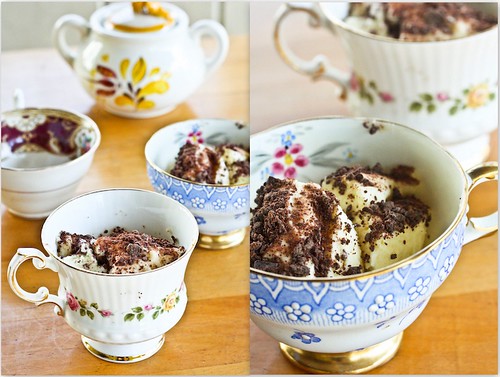Here's a bit of back story. R is from Norway. He's from a small town (by my standards!) on the Southwestern coast called Haugesund, so the theme for our Norway in New York feast is foods from his region of Norway. R and I were married last June, and since we met I've been exploring Norwegian recipes off and on. For our wedding, his sister and brother had our guests play a game. They passed out 12 balloons, one for each of the twelve months of our first year of marriage. When a guest popped their balloon, they had to complete the task written on the piece of paper they found inside during the month they'd been assigned. This is all to say that R's other sister was charged with translating some of their family recipes for us. She did this all the way back in October, I think, but I was studying for orals then and, if you'll remember, not cooking. So several of these recipes are R's old family recipes, translated by his sister.
Another source for these recipes is a book that R's parents gave me for my birthday (also last October!) called Norwegian National Recipes, by Arne Brimi and Ardis Kaspersen. These are very authentic recipes, organized by region. All of the recipes used here come from the section dedicated to the region around Haugesund.
Finally, the last source for these recipes is yet another cookbook R's parents gave to me for my birthday. It's called Haugesund Husmorskoles Kokebok, and it was the text book produced for a college in Haugesund in 1929 dedicated to teaching young women home economics. The book was a compendium of the recipes which the students had been cataloguing since the school's founding in 1913. The book ended up being something of a classic in Norwegian cooking because it's full of all sorts of traditional recipes. In fact, it's been reprinted 23 times since it's first run, and can be found in most everyone's kitchen in Haugesund, partly because the local bank gave it out to women on their confirmation. The fact that there are no pictures can make it a little difficult if you don't know anything about Norwegian cooking (not to mention that it's only in Norwegian!) but luckily R was there to make sure everything went well and that everything was done correctly. I've stayed as true to the recipes as possible, not being in Norway and all. When I write out the recipes, I've used my sister-in-law's and R's translations, and elaborated on them a bit to make them accessible to an American kitchen which probably lacks a real live Norwegian standing over you making sure things are done correctly!
 Another view of Norway!
Another view of Norway!Before we get started with the food, I must mention that this was totally a joint effort between R and myself. We split the cooking and I relied on him to translate recipes and to make sure things were done according to tradition. I would also like to dedicate this post to R and to my family-in-law, for introducing me to Norwegian cooking. You can click on the title of the recipes below to be directed to a post which explores each recipe in more depth.
Okay, so let's start with appetizers and drinks. The first thing we made was a Norwegian Berry Drink called Rå bringebærsaft. As someone who doesn't drink alcohol a whole lot, it was really refreshing to have a non-alcoholic drink meant to compliment a meal.

We then set out a spread that consisted of Stavanger Herring Salad and its accompaniments:

Along with the Herring Salad, we made Potato Lefse, a Norwegian flat bread:

Herring is also normally served with a Cold Potato Salad, so we did that, too:

The Herring should be scooped up with, or wrapped inside, the lefse with a helping of potato salad on the side.
For our main courses, we cooked up two dishes. One a bit more time intensive than the other. The first one, which takes a bit less commitment, was a Sour Cream Porridge, or Rømmegrøt. Rømmegrøt is usually served with a cured mutton called fenalår, which I explain in more detail (and show you!) if you click through to the recipe.

Our next main dish was one of R's favorites. It's called Komler, and it's basically potato dumplings stuffed with a little piece of bacon, simmered in meat broth. It's served with boiled or mashed carrot and rutabaga, as well Norwegian sausage. You can find all about it in its dedicated post.

For our desserts, we made two of R's favorites. The first is called Dronning Maud Pudding, named for Norway's first queen. It was developed in Haugesund, but the name was changed for reasons I go into in the dedicated post.
Our final dessert is called Kvæfjordkake, named for a fjord in the north of Norway. It also goes by the name of Verdens Beste, or World's Best, and after tasting it, I'd have to agree. It's built around two pieces of meringue baked on top of a thin layer of cake, that then sandwiches a filling of vanilla cream. I predict that it will be the next big thing. So click through and read about it now!




No comments:
Post a Comment